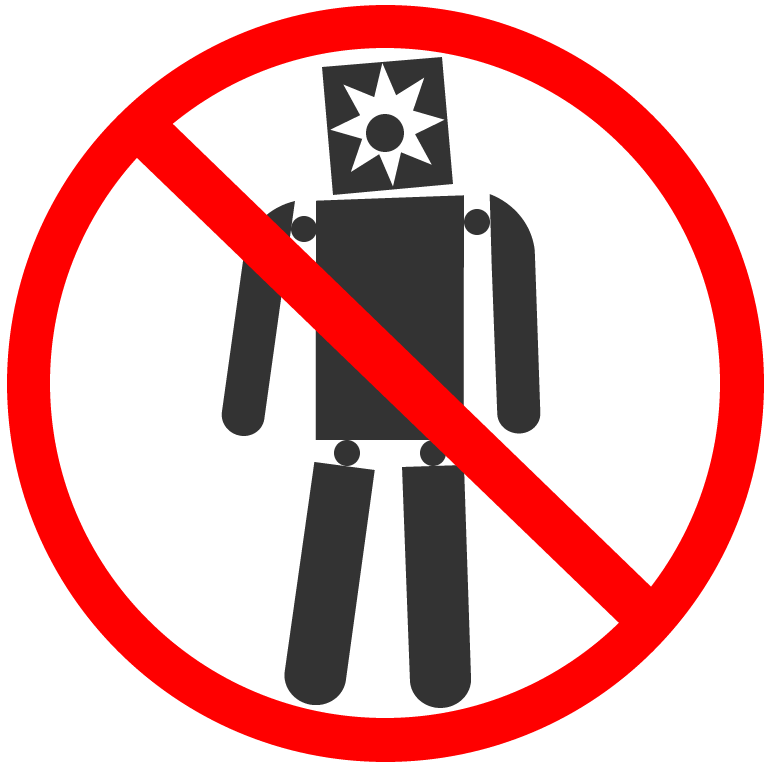
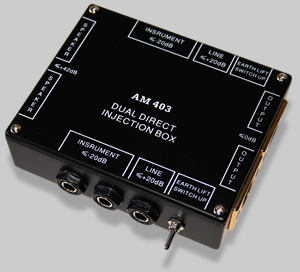
AM 403
The new price of an AM 403 Dual Direct Inject Box can be around AUD $60 on eBay (includes postage). Realistically speaking, you probably couldn't buy the parts inside it for that money, let alone fabricate a case and pair of circuit boards.
I've never seen a used AM 403 for sale, but if one came along for under AUD$40, it would be worth buying, if only for the two balanced output transformers.
My suspicion though is that anyone who has one of these will be keeping it ;-))
GEAR RELATED ARTICLES
[Home Music Recording Studio]
GUITAR AMPLIFIERS:
Acoustic 450 - 170W Guitar / Bass Amp Head
Behringer Ultrabass BXL1800A 180W Bass Amp
Fender Princeton Chorus 51W Compact Amp
GUITARS:
Aspen AD25 6 String Acoustic Guitar
Esteve Model 8 Classical Guitar
La Patrie Concert CW QIT Classical Guitar
La Patrie Presentation Classical Guitar
Fender DG-14SCE Nat Acoustic Guitar
Godin XtSA Electric Guitar
Godin Freeway Classic Electric Guitar
Ibanez RG8 8 String Electric Guitar
Jim Beam Devil's Cut 335 clone
Maton EM125C - 6 String Acoustic Guitar
Maton EM425C/12 12 String Acoustic Guitar
Maton Mastersound MS500 - 6 Str Electric Guitar
Yamaha FG-410-12A 12 String Acoustic
Yamaha G-228 6 String Classical
GUITAR FX - The Chronicles of Zoom:
ZOOM GFX-707 - Review and Description
ZOOM 707 II - Review and Description
ZOOM BFX-708 - Bass Guitar Multi Effects Pedal
ZOOM G9.2tt - Guitar Effects Console
Behringer EM600 Echo Machine Stomp Box
Behringer RV600 Reverb Machine Stomp Box
ROLAND U-220 - Vintage Sound / Synth Module
SN-U110 and SN-MV30-S1 Series PCM Cards
Behringer FBQ1502HD Ultragraph Pro
Behringer Eurorack Pro RX1602 Rackmount Mixer
Capabilities of the CASIO WK-7500 Workstation
Presonus Eris E5 Powered Monitor Speakers
Vonyx (Skytec) SPJ-1000A Active 10" Speaker
[ Advertising ]
The AM403 (aka SoundKing) Dual Direct Inject (DI) Box can be summed up as simple, sturdy and efficient. The AM403 is an all passive DI Box that is well constructed from quality parts. The case is all metal, providing good RF shielding. The layout allows for useful implementation options.
The AM 403 is an extremely densely packed unit. There is literally no spare space inside. In fact, it's so tight, that once assembled it would be a major task to effect repairs.
What is a Direct Inject or DI Box:
A Direct Inject or DI box allows unbalanced and generally high impedance, higher energy signals (e.g. line Level, guitar level) to be converted to balanced and low impedance signals (e.g. microphone level). These balanced, low impedance signals can then be sent down longer cables with less noise and signal degradation. At the receiving end they can be plugged directly into the balanced microphone input of a mixing desk or recording console.
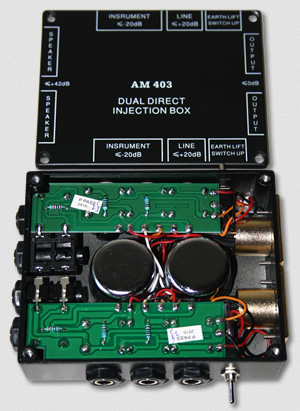 Since the AM403 is passive, there are no batteries or power connections needed, and no internal amplifiers to add noise. There will however be some harmonic distortion due to the transformers, this may be as high as 5%. Sadly, transformer distortion figures are rarely available in passive DI Box specifications. But really, they should be.
Since the AM403 is passive, there are no batteries or power connections needed, and no internal amplifiers to add noise. There will however be some harmonic distortion due to the transformers, this may be as high as 5%. Sadly, transformer distortion figures are rarely available in passive DI Box specifications. But really, they should be.
In my case, I wanted to DI the speaker output from a Boutique 20W (aka Lunch-Box) valve amp. So any transformer distortion is likely to go totally unnoticed ;-)
For some uses though, you might be looking for better quality (and almost certainly more expensive) transformers, where the manufacturer is prepared to boast about how little distortion there is.
I say this because the whole AM 403 costs less than what you may pay for just a single balanced output transformer. In the photo to the right, the transformers are enclosed in the shiny stainless steel cans in the centre of the unit.
See also - Amplifier Dummy Load for use with a Direct Inject (DI) Box
Download a scanned copy of the AM401 / 402 / 403 / 404 User Manual in PDF format.
For the AM 403, the following items are duplicated for the second channel.
Inputs
- Speaker Level (<+42dB)
Two 6mm sockets in parallel are provided to allow the AM403 to be connected in series between a power amp and its speaker(s).
[Amp] - (input 1 DI Box)--(input 2 DI Box) - [Speaker]
Important Note When Using the DI Speaker Input:
When connecting a DI (Direct Inject) device to a power amplifier's speaker output, make sure that the amplifier is also connected to a properly rated speaker, speaker cabinet or suitable resistive load (e.g. Dummy Load).
Improper output loading, sometimes referred to as a Floating Output, may result in damage to your amplifier's output stages ... a translation into plain English: 'very expensive!'
( Amplifier Dummy Load for use with a Direct Inject (DI) Box )
- Line Level (<+20dB)
Single 6mm socket. For use with the line out from a guitar amp or other device.
- Instrument Level (<-20dB)
Two 6mm sockets in parallel are provided to allow the AM403 to be connected in series between the Guitar/Effects and the guitar amplifier.
In this configuration one socket may used as input, the other as output. Since the effective result is that of a through connection, it doesn't matter which is assigned as in or out. The signal from that point can be sent (via the transformer) to other equipment using a blanced cable (mic input / mixer, DAW, monitor amp, more effects / amps e.g: AXE FXIII, etc.).
Controls
- Ground Lift Switch
Physically disconnects the Input Ground from the Output Ground (which is connected to the case). A floating Ground can increase noise in some situations - test first, use with caution.
Outputs
- Microphone Level (approximately)
For a balanced 600Ω load (or greater) suitable for connection to a mixing / recording console via standard XLR connector.
Possible Uses Include:
- Capturing the full output distortion of a tube amp, by taking the signal from the output of the Power Amp rather than from the Line Out from the Pre Amp. To avoid damage to your amp, make sure the amp's output is appropriately loaded when not using speakers. This is actually a great way to get a nice fat tube distortion sound without having to worry about outrageous sound pressure levels.
- Being able to dump a line or instrument level signal straight into a mixing/recording console at microphone level and impedence.
- Reducing noise and signal degradation levels where extra long leads are required by replacing unbalanced leads with balanced ones.
This becomes progressively more significant with lead lengths beyond about 4 metres (13 feet). A combination of signal loss over distance, RF (Radio Frequency) noise, other induced noises (mains hum and lighting control glitches) and also increasing capacitance within the guitar lead itself - all conspire to degrade signal integrity as distance increases.
Pros:
- Solid / Sturdy
- Seemingly Good Quality Parts
- Simple to Operate
- Compact (couldn't physically be any smaller ;-)
Cons:
To address and/or accommodate most of the cons mentioned below the device would have to be housed in a larger box. So the points mentioned below are more of a 'wishlist', rather than a criticism. If the AM 403 is taken as-is, there really isn't anything to complain about. It does exactly what it sets out to do.
- There is no online support, web site or even official PDF manual to download (a scanned copy is available here though). This is very much a case of, you get what's in the box and not a skeric more. This product (and it's related products, as sown in the manual), may not be available all the time.
- The Ground Lift switch is the only thing that protrudes from the case, making it vulnerable to breaking off (it happens!). A flat sliding switch would have been preferable (but would also increase manufacturing / assembly costs).
- An RCA connector would have been useful as a Line In option.
- Speaker attenuation - The available attenuation ratio of 100 to 1 is rather severe. A 50 to 1 attenuation ratio option would have been good for those of us who don't run 100W+ amps, flat-out, all the time.
- An attenuation selector switch for more options. A simple 0dB / -3dB (or perhaps 0dB / -6dB) option would do.
- The extremely compact nature of this DI Box makes modifications and/or additions pretty much impossible. To mod this unit will almost certainly require a larger case ... which would be somewhat of a waste.
AM 403 Schematic:
As far as electrical devices go, the AM 403 is very simple. Essentially, the the inputs are voltage divided to bring them down to an acceptable level for the transformer to deal with. The transformer then converts a high impedance unbalanced signal into a low impedance balanced one, ready to be connected to an XLR mic input on a mixer or recording console. Simple, clean and effective.
The quality of the transformers (which I can't comment on) would be the only potentially limiting factor. However, given that the quoted frequency response is 30Hz to 30KHz (+0/-1 dB), it's not looking at all shoddy. Being a transformer coupled device however, there is likely to be some inherent distortion, though there are no distortion figures provided (which seems to be quite common for DI boxes). There really should be THD figures for such devices.
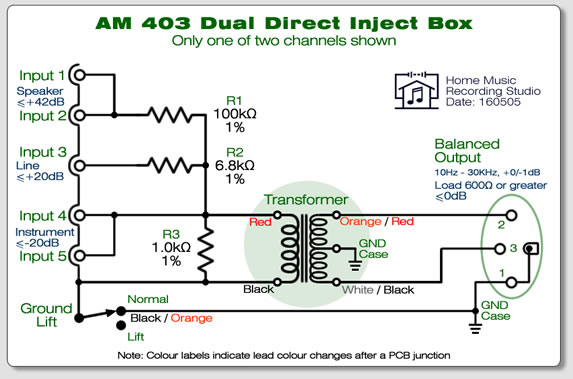
Some AM 403 Applications:
Please note that in all the examples below, it is assumed that the balanced output will be connected to a balanced input (e.g. mixer), though this is not a requirement.
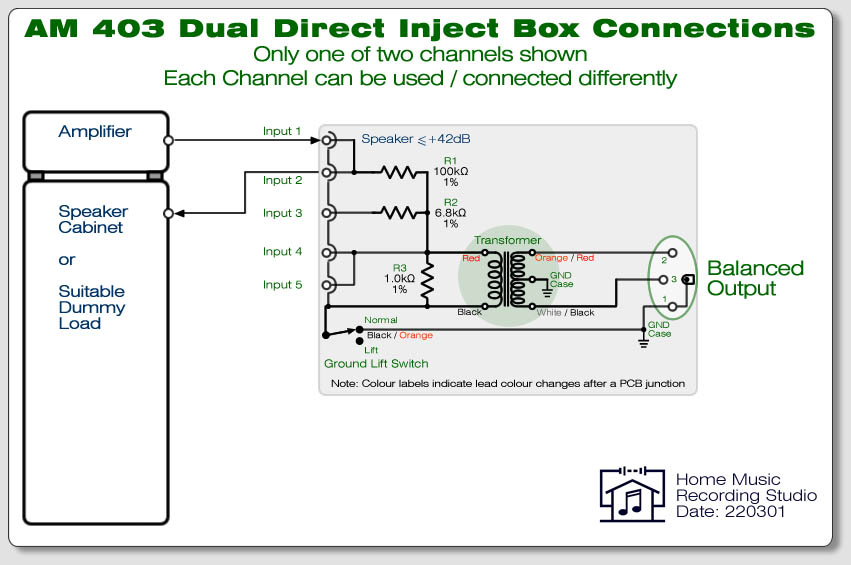
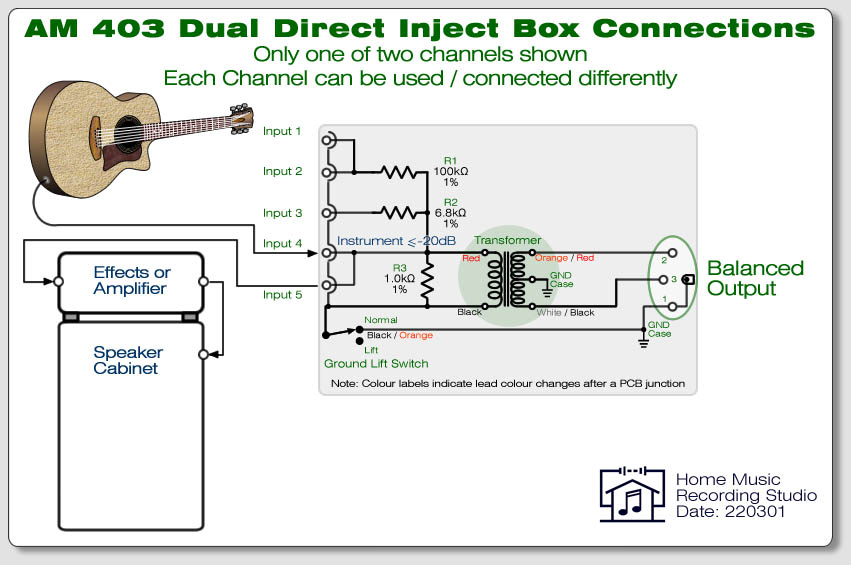
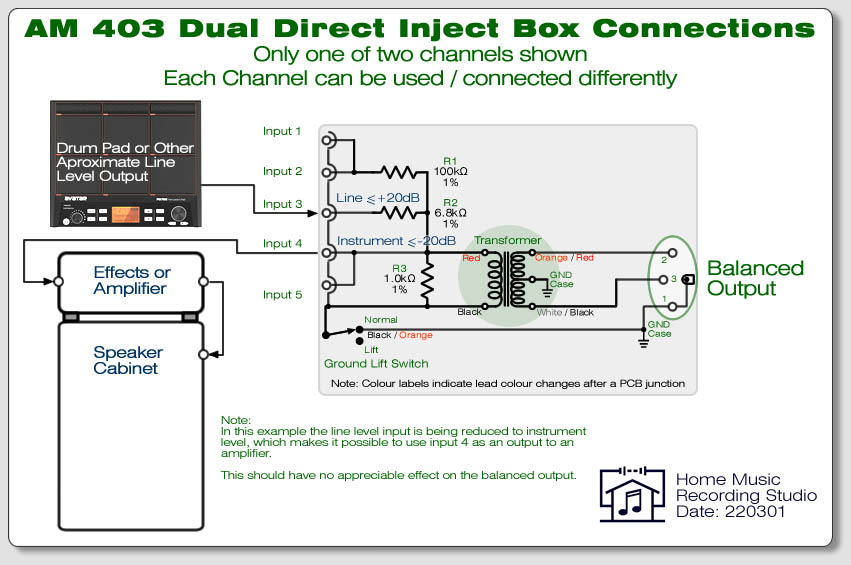
See also - Amplifier Dummy Load for use with a Direct Inject (DI) Box
AM 403 Dual Direct Inject Box Summary:
So how does the AM 403 shape up?
As far as features go, I would like to see a padding option (-3dB or -6dB), so 9/10.
The AM 403 doesn't need batteries or power, so it's just a matter of connecting the relevant ins and outs and you're good to go (remember the warning above about proper speaker loading if using the speaker connections), so it's 9/10 for ease of use.
Build Quality, Durability and Reliability are a straight up 10/10.
Value for money is Excellent. To build a unit like this, you wouldn't be able to source the parts for the price of this unit. Added to that, the price compares very favorably to other 'Brand Name' units which may cost twice as much or more. So another 10/10.
Review Ratings:
- Features - 9 / 10 (would benefit from a padding switch)
- Ease of Use - 9 / 10 (speaker loading required)
- Build Quality - 10 / 10
- Durability & Reliability - 10 / 10
- Value for Money - 10 /10
- Overall Average Score ... 9 / 10 (ridiculously close to a 10/10)
Was this page useful?
Rate This Page:
| Page Ratings so far ... | ||
| Excellent | 10 | |
| Very Good | 1 | |
| Useful | 0 | |
| Not Useful | 0 | |
| TOTAL | 11 | |
Page online for years
Your Comments:
191003 - (Excellent) Thanks for all the detailed information!
Not sure I got the whole part about the amplifier inputs but I'll read your "Amplifier Dummy Load for use with a Direct Inject (DI) Box".
Question though - Don't you find it irritating that the input levels printed on the case are not specified as dbV or dbU?
One more question - say I record an electric guitar and I want to split it - get a crappy clean DI sound in addition to the Amp sound (recorded using a microphone) how do I do so with this DI? Obviously I hook up the pickup to the instrument input (to be outputed to a recording console via XLR) but which of the DI's outputs should I use to connect to the guitar input of the amp?
Editor's Note:
Re: "amplifier inputs": I guess a diagram would be useful there. When I get a minute or five ... [Done!]
Re: "specs in dBv or dBu".
Admittedly, this is a very messy and potentially confusing space. In part this is because the terminology has been adapted across several distinct fields of knowledge, e.g.: physics, electronics, acoustics. Then also subdivided into professional and domestic use categories, just to make sure that no-one can easily get their head around it
![]()
However, for those who don't know:
dBV and dBu are reference voltages that are stated as specific values. For example:
dBV stands for deciBel Volts, where 1.0000 volt ≡ 0 dBV, and
dBu stands for deciBel unloaded where 0.7746 volt ≡ 0 dBu
(see here ![]() for further details and conversions)(≡ means 'exactly equals').
for further details and conversions)(≡ means 'exactly equals').
The dB (deciBel) is used to describe a relative value and is therefore used to compare two levels - rather than state an absolute level or value. To say that speaker A has a sound pressure level that is 6dB more than speaker B, is the same as saying that speaker A is twice as loud as speaker B (acoustically). This is a comparison without referring to wattage or actual input and/or output levels. Note however that a speaker's SPL (Sound Pressure Level) is usually specified as a ...1 KHz signal at an output level of 1W (Watt), measured at a distance of 1 metre.
For the DI Box above, there is only a simple resistor voltage divider network in use to reduce the level of the various inputs.
Essentially, one could connect any level of signal to any of the inputs (as long as the resistors or transformers survived), and that signal would always be reduced by the same relative amount.
So the DI Box inputs are marked to "suggest" what might be appropriate for a given task based on the signal level one is working with.
For example: The output of a guitar multi-effects unit will often lie between instrument level and line level. So, if you are using the device (cranked up) closer to or at line level, use input 3. If using the device with the level trimmed down closer to instrument level, use input 4 or 5. Then tweak or trim at the mixing console.
It may take a little experimentation to get the best outcome for a given situation. Ideally you send the maximum signal level to the mixing desk (or whatever next stage) without clipping, so that the input gain at the desk can be trimmed right down for minimum noise and distortion. Knowing this shit is essentially what audio engineers get paid for ;-)
And to the last question:
A straight guitar signal would go into one of the "instrument" inputs
(input 4 or 5). These are tied so it doesn't matter which.
Line Level goes to input 3 and speaker output (via a dummy load) to inputs 1 or 2.
Incept Date: Wizard - 160510
Last Update: Wizard - 240401
